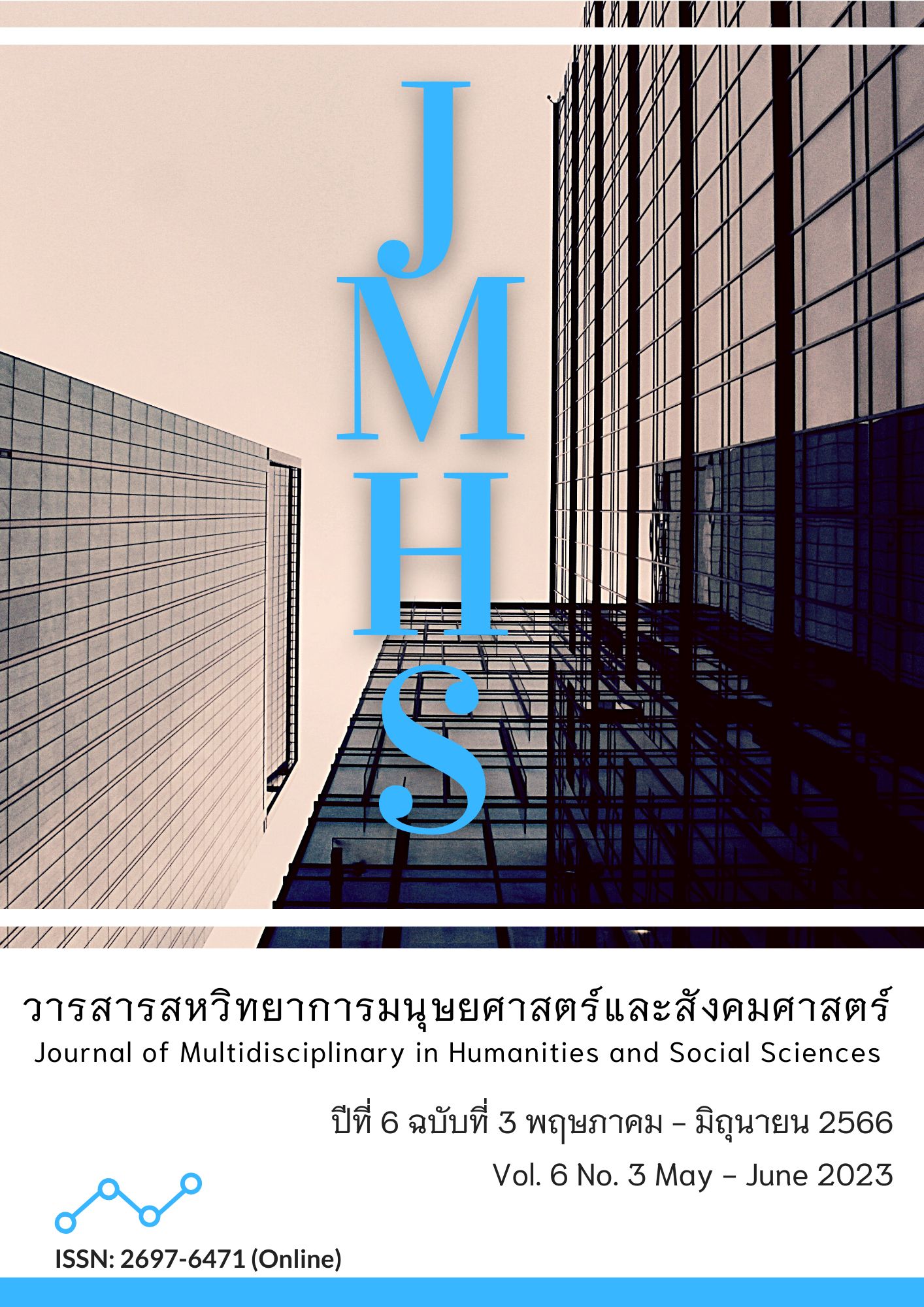Causal Factors Influencing Purchase Intention Cosmetic via Tiktok Application in Thailand
Main Article Content
Abstract
The article aimed to 1) develop and validate a causal relationship model of purchase intention for cosmetics via the Tiktok application in Thailand, and 2) study causal factors affecting purchase intention for cosmetics via the Tiktok application in Thailand. This study was quantitative research. The tools used in the research were online questionnaires. The sample consisted of 420 people who had bought cosmetics via the Tiktok application and lived in Thailand by convenience sampling. The statistics used in data analysis were frequency, percentage, confirmatory factor analysis, and the structural equation model.
The research results were as follows: 1) The causal relationship model consisted of 4 components: trust, value, satisfaction, and purchase intention, and the model is consistent with the empirical data to a great extent. The statistic showed CMIN/df = 1.93, GFI = 0.94, AGFI = 0.90, SRMR = 0.03, and RMSEA = 0.05. The final predictive coefficient was 0.81, indicating that the variables in the model can explain the variance of the purchase intention via the Tiktok application by 81 percent. 2) It was found that customer satisfaction, customer trust, and value had respective influences on the purchase intention of cosmetics via the Tiktok application in Thailand. Entrepreneurs who sell cosmetics can use the research results for planning and creating strategies to suit their customers. Therefore, it can create purchase intentions in the future.
Article Details

This work is licensed under a Creative Commons Attribution-NonCommercial-NoDerivatives 4.0 International License.
Views and opinions appearing in the Journal it is the responsibility of the author of the article, and does not constitute the view and responsibility of the editorial team.
References
จันทร์เพ็ญ วรรณารักษ์ และ คณะ. (2559). อิทธิพลของคุณภาพการบริการและความพึงพอใจของลูกค้าต่อความตั้งใจซื้อสินค้า ร้านค้าในเฟสบุ๊ก. วารสารวิชาการ มทร.สุวรรณภูมิ(มนุษศาสตร์และสังคมศาสตร์), 1(1),43-53 สืบค้นจาก https://so05.tci-thaijo.org/index.php/rmutsb-hs/article/view/96448
โต๊ะข่าวไอที ดิจิทัล. (2565). ข้อมูลล่าสุดสถิติใช้ดิจิทัลในไทย จากรายงาน We are social. สืบค้น 29 ตุลาคม 2565, จาก https://www.bangkokbiznews.com/columnist/989552
ฐาณุพัชช์ จิตภักดีภรรัชต์. (2564). ผลกระทบของอัตลักษณ์อาหารริมทางที่ส่งผลต่อความตั้งใจซื้อความพึงพอใจ และการบอกต่อของลูกค้ากลุ่มเจเนอเรชั่นซี. วารสารเครือข่ายส่งเสริมการวิจัยทางมนุษยศาสตร์และสังคมศาสตร์, 4(1), 14-28. สืบค้นจาก https://so06.tci-thaijo.org/index.php/hsrnj/article/view/252047
ทิวาวรรณ ศรีสวัสดิ์. (2559). โมเดลความสัมพันธ์เชิงสาเหตุของการเกี่ยวข้องกับสถานการณ์และความไว้วางใจที่มีต่อการตั้งใจเลือกซื้อจากร้านค้าออนไลน์ของผู้บริโภคชาวไทย. วารสารวิทยาลัยพาณิชยศาสตร์บูรพาปริทัศน์, 11(2), 31-46. สืบค้นจาก https://so02.tci-thaijo.org/index.php/GSC/article/view/73691
ธนชาติ นุ่มนนท์. (2565). โลกก้าวเข้าสู่ยุค Digital Transformation 2.0. สืบค้น 29 ตุลาคม 2565, จาก https://www.bangkokbiznews.com/columnist/980464
ธีรศักดิ์ จินดาบถ, สุนันทา เหมทานนท์ และ พิไลวรรณ ประพฤติ. (2561). การรับรู้คุณค่าและความตั้งใจซื้อผลิตภัณฑ์ยางของผู้บริโภคชาวไทย. วารสารบริหารธุรกิจศรีนครินทรวิโรฒ, 9(2), 106-116. สืบค้นจาก https://ejournals.swu.ac.th/index.php/MBASBJ/article/view/10679
เบญญา หวังมหาพร และ ทิพย์รัตน์ เลาหวิเชียร์. (2563). ผลของความไว้วางใจและคุณค่าที่รับรู้ได้ต่อการตั้งใจซื้อสินค้าผ่านทางสังคมออนไลน์เฟซบุ๊กของผู้ใช้ในเขตกรุงเทพมหานคร. BU Academic Review, 19(2), 151-163. สืบค้นจาก https://so01.tci-thaijo.org/index.php/
buacademicreview/article/view/240265
รุ่งอรุณ กระแสร์สินธุ์, วิษณุ เพ็ชรไทย, ชตินันท์ เจียมจิระเศรษฐ์, วรรณพล ศุภสกุลดํารงค์, บุณยวีร โชคประเสริฐสม และ ใกล้รุ่ง กระแสร์สินธุ์. (2565). ความพึงพอใจของนักศึกษาที่มีต่อการให้บริการของสำนักงานทะเบียนและประมวลผล สถาบันเทคโนโลยีไทย-ญี่ปุ่น (ในช่วงเวลาการแพร่ระบาดของโรคติดเชื้อไวรัสโคโรนา 2019). วารสารวิชาการ สมาคมสถาบันอุดมศึกษาเอกชนแห่งประเทศไทย ในพระราชูปถัมภ์ สมเด็จพระเทพรัตนราชสุดาสยามบรมราชกุมารี, 28(1), 80–97. สืบค้นจาก https://so06.tci-thaijo.org/index.php/apheit-ss/article/view/25606
วรรณเทพ จันทร์จรูญจิต และ สมชาย เล็กเจริญ. (2563). รูปแบบความสัมพันธ์เชิงสาเหตุความภักดีที่มีต่อตราสินค้ายูนิโคล่ผ่านสื่อสังคมออนไลน์ของผู้บริโภคในเขตกรุงเทพมหานครและปริมณฑล. วารสารปัญญาภิวัฒน์, 12(3), 120–133. สืบค้นจาก https://so05.tci-thaijo.org/
index.php/pimjournal/article/view/240224
สมชาย เล็กเจริญ และ ณวรรษ ชัยศรี. (2564). ปัจจัยเชิงสาเหตุที่มีผลต่อความตั้งใจซื้อสินค้าแฟชั่นบนอินสตาแกรมของผู้บริโภคในประเทศไทย. วารสารศิลปการจัดการ, 5(2), 513-528. สืบค้นจาก https://so02.tci-thaijo.org/index.php/jam/article/view/248325
สมชาย เล็กเจริญ และ ชัญญา นุตตะไลย์. (2565). ปัจจัยเชิงสาเหตุที่มีอิทธิพลต่อความตั้งใจซื้อบัตรคอนเสิร์ตบนแอปพลิเคชันทิคเก็ตเมล่อนของผู้บริโภคในเขตกรุงเทพมหานครและปริมณฑล. วารสารบัณฑิตศาส์น มหาวิทยาลัยมกุฏราชวิทยาลัย, 20(1), 15-24. สืบค้นจาก
https://so04.tci-thaijo.org/index.php/mgsj/article/view/259974
สาวิตรี อมิตรพ่าย และ พิมพ์ สุนสวัสดิ์. (2559). ปัจจัยที่มีอิทธิพลต่อความตั้งใจซื้อบริการห้องพักโรงแรมโดยการจองผ่านเว็บไซต์ธุรกิจตัวแทนการท่องเที่ยว. วารสารวิทยาการจัดการ, 33(2), 107-134. สืบค้นจาก https://so03.tci-thaijo.org/index.php/jms_psu/article/view/75241
สุมามาลย์ ปานคำ และ ภัคจิรา ชื่นโพธิ์กลาง, (2565). ปัจจัยเชิงสาเหตุที่มีอิทธิพลต่อความตั้งใจซื้อสินค้าร้านคาเฟ่อเมซอน บนแอปพลิเคชันไลน์แมนของผู้บริโภคในกรุงเทพมหานครและปริมณฑล. วารสารสหวิทยาการมนุษยศาสตร์และสังคมศาสตร์. 5(3), 1120-1136. สืบค้นจาก https://so04.tci-thaijo.org/index.php/jmhs1_s/article/view/257655
อรนุช อุปนันท์, สืบชาติ อันทะไชย และ พนา ดุลยพัชร. (2561). อิทธิพลเชิงสาเหตุของส่วนผสมทางการตลาดบริการที่มีต่อการรับรู้คุณค่า ความพึงพอใจ และความภักดีของผู้บริโภคของร้านค้าเครื่องประดับอัญมณี. วารสารวิชาการและการวิจัยมหาวิทยาลัยภาคตะวันออกเฉียงเหนือ, 8(2), 82-83. สืบค้นจาก https://so04.tci-thaijo.org/index.php/neuarj/article/view/201445
García-Salirrosas, E.E., Acevedo-Duque, Á., Marin Chaves, V., Mejía Henao, P.A., & Olaya Molano,J.C. (2022). Purchase Intention and Satisfaction of Online Shop Users in Developing Countries during the COVID-19 Pandemic. Sustainability, 14(10), 6302. https://doi.org/10.3390/su14106302
Hair, J. F., Black, W. C., Babin, B. J., & Anderson, R. E. (2010). Multivariate Data Analysis. (7th ed.). New Jersey: Prentice Hall.
Hair, J. F., Hult, G. T. M., Ringle, C. M., & Sarstedt, M. (2014). A Primer on Partial Least Squares Structural Equation Modeling (PLS-SEM). California: Sage..
Hoelter, J. W. (1983). The Effects of Role Evaluation and Commitment on Identity Salience. Social Psychology Quarterly, 46(2), 140–147. https://doi.org/10.2307/3033850
Joreskog, K. G., & Sorbom, D. (1984). Advances in factor analysis and structural equation models. Lanham: Rowman & Littlefield.
Kline, R. B. (2011). Principles and Practices of Structural Equation Modeling. (3rd ed.). New York: The Guilford.
Schreiber, J. B., Stage, F. K., King, J., Nora, A., & Barlow, E. A. (2006). Reporting Structural Equation Modeling and Confirmatory Factor Analysis Results: A Review. The Journal of Educational Research, 99(6), 323–337. Retrieved from https://doi.org/10.3200/
JOER.99.6.323-338
Schumacker, R. E., & Lomax, R. G. (2004). A Beginner's Guide to Structural Equation Modeling (2nd ed.). New Jersey: Lawrence Erlbaum Associates.
Thompson, B. (2004). Exploratory and confirmatory factor analysis: Understanding concepts and applications. American Psychological Association. https://doi.org/10.1037/10694-000
Tiktok. (2565). เจาะลึกเหตุผลที่ทำให้ TikTok เป็นแพลตฟอร์มมาแรงแห่งปี. สืบค้น 29 ตุลาคม 2565, จาก https://newsroom.tiktok.com/th-th/top-reasons-why-everyone-heard-about-tiktok.
Ullman, M. T. (2001). The Declarative/Procedural Model of Lexicon and Grammar. Journal of Psycholinguistic Research, 30(1), 37–69. https://doi.org/10.1023/A:1005204207369
We are social. (2022). Digital 2022: Another Year of Bumper Growth. สืบค้นเมื่อ 12 เมษายน 2565, จาก https://wearesocial.com/uk/blog/2022/01/digital-2022-another-year-of-bumper-growth-2


